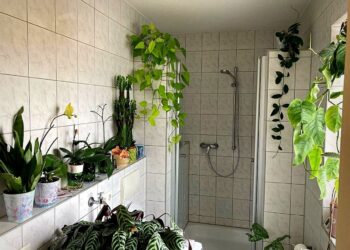So you’ve decided that your next venture for the indoor garden will be ferns, but you’re not sure exactly how to grow them? Most ferns are quite easy to care for and thrive in low-light conditions. There are only a few points to consider if you want success with your ferns.
Ferns are some of the oldest plants on earth and can be found in an astonishing array of environments and sizes. Fern species range from temperate to tropical. The sizes also vary from miniature ferns that you can keep in a tiny pot to monstrous tree ferns like the ones found in New Zealand and Australia. For the best results, use the guidelines below to grow your ferns successfully.
Guidelines For Growing Most Ferns:
Humidity
All ferns love moisture and should be kept in a humid environment. Ferns do not tolerate being dry for long periods. Their fronds will turn brown and they will begin to drop their leaves. Mist your fern as often as practically possible. It is best to mist in the morning, but keep a spray bottle handy for misting whenever you walk past your plant.
The only time misting will not be required is if your fern lives in the bathroom where humidity is generally high or if you invest in a humidifier for the room. You can also place your fern on a tray of clay granules or pebbles that are kept wet. This will increase the humidity around your plant without keeping the roots soggy.
Substrate
It is important to have the right substrate for your ferns. Ferns naturally grow in soil with high humus content. Make sure the substrate you use is free draining to prevent your fern’s roots from getting waterlogged. You want your fern to always be moist but not soaking wet. A substrate with plenty of sand that contains peat or at least a fibrous peat substitute is best.
Never allow your substrate to dry out. This may mean watering your plant every day. If your summers are very hot and dry, you might have to water your fern twice a day with misting in between. Take care to never keep your fern sitting in water for long periods, unless it is a bog fern. Letting your fern sit in water for too long can cause root rot.
Ferns thrive in the loamy soil of damp environments. When the top layer of soil in your ferns pot feels dry to the touch, water your fern.
Fertilizer
Ferns naturally grow in soil with a steady supply or decaying organic matter. This means that in the growing season it is best to supply your fern with a steady supply of weak fertilizer. A weak liquid fertilizer or a slow-release pellet is perfect for this job.
If you’re using a liquid fertilizer, mix a few drops with your water for misting. Make sure you know the fern you are growing. Some ferns have more specialized requirements. Don’t feed your ferns in winter, they need the time to rest.
Light
Even though most ferns grow in moist, shady places like the forest floor, this does not mean that they are deep shade plants. Most ferns like dappled shade. If the level of light in your home is too low, you will see poor growth and yellowing fronds. Put your ferns in a window that receives gentle morning or afternoon sun, but keep them out of the strong midday sun.
You can keep your ferns in deep shade if you give them regular breaks in strong light. Artificial light can be provided with a special gardening bulb to supplement natural light if necessary.
Temperature
Your fern’s place of origin and adaptability will determine how high or low a temperature it will need to thrive. Most ferns do not like to get cold. Tropical ferns appreciate a temperature between 60-70F (15-21C). Those from more temperate conditions enjoy 50-60F (10-16C).
If you do not feel like struggling to keep the temperature optimal, get a fern adapted to the temperature range of your home. Ferns of tropical origin do especially well in houses with central heating.
Repotting
Ferns can be repotted in springtime. Before repotting your fern, make sure that the roots are actually filling the pot. If your fern does not need repotting yet, just scrape off the top layer of soil and replace it with fresh compost.
Cut off any damaged or dead fronds to encourage new growth. When repotting, you can split your fern into two. You can also use the powdery spores which can be found underneath the leaves to grow new ferns.
A Quick Summary
As you now know, growing ferns are pretty straightforward. Ferns are relatively easy to care for if you follow the above guidelines. Here is a quick recap of those guidelines:
- Keep your ferns in a humid environment, mist them often.
- Make sure to give your fern substrate that drains well.
- Use a few drops of liquid fertilizer in your misting water.
- Supply your fern with ample gentle or dappled light.
- Make sure to provide the right temperatures for the type of fern you are keeping.
- Only repot your fern once it is rootbound.
For the best results, make sure to pick a fern with an appropriate maximum size for your needs and know where your fern originated from to best take care of its needs. Now, let’s grow some ferns!
You may also like:














Discussion about this post